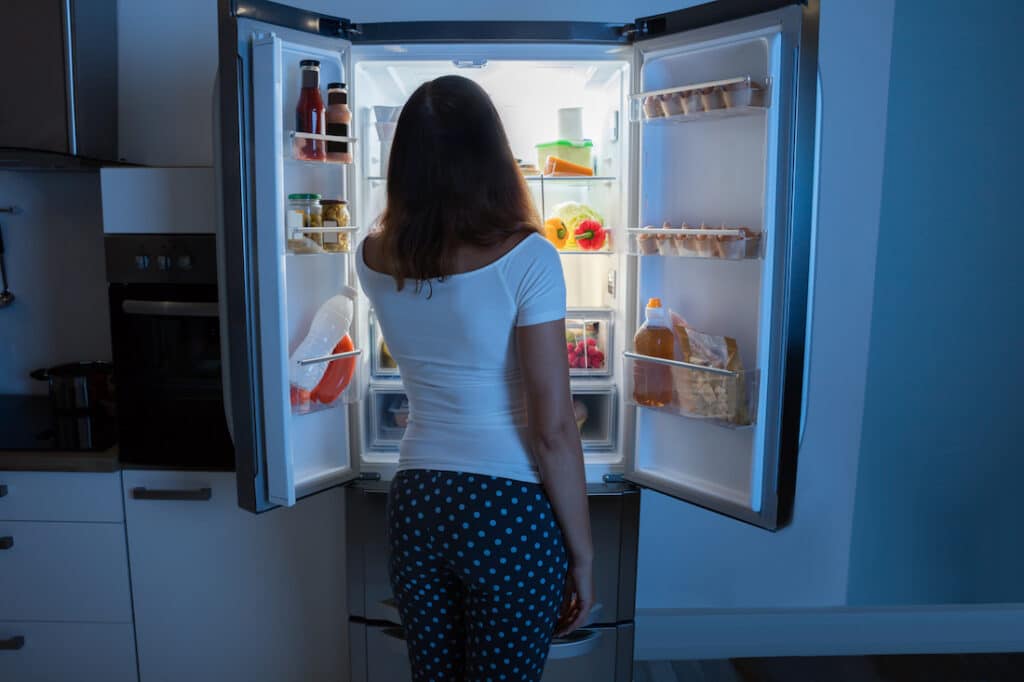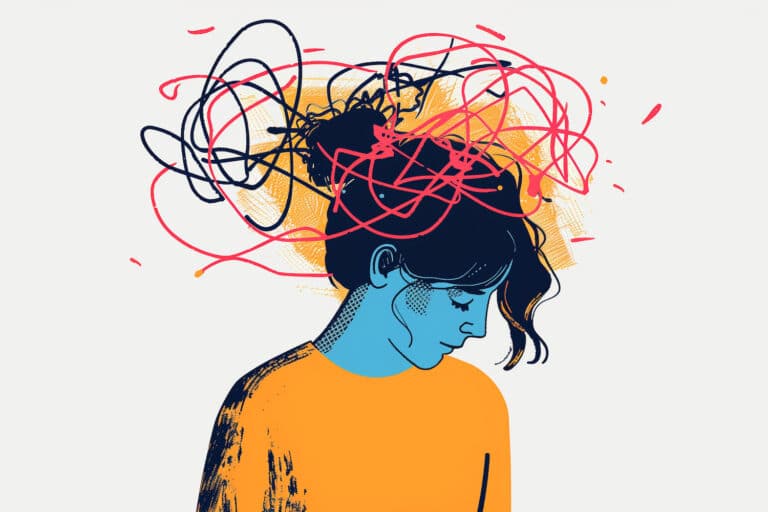It’s not unusual to hear people use buzzwords like “stress eating” or “comfort food” to describe their ice cream indulgence at the end of a long work week. These phrases stem from a widespread tendency to reach for food when we feel stressed, bored, worried, or grief-stricken; formally, it’s called emotional eating.
While we all engage in emotional eating sometimes, it can become a problem when food is your primary method of coping with negative or complex feelings.
What Is Emotional Eating?
Emotional eating is when you turn to food for comfort when you experience negative emotions. For example, you may reach for good-tasting foods like chips or cookies when you feel sad or anxious, not because you’re hungry but because you’re seeking the emotional rewards produced by those foods.
Everyone is an emotional eater sometimes, and there’s usually nothing wrong with it. But when food is your primary (or only) method for navigating the stresses in your life, it can signal a more serious underlying problem. Emotional eating becomes concerning when it causes disordered eating behaviors; it may also lead to eating disorders such as anorexia, bulimia, or binge-eating disorder (1).
How Does Emotional Eating Differ from Regular Eating?
Emotional eating differs from regular eating because it has different triggers and serves a different purpose. Regular eating, or taking in nourishment when you feel hungry, is a way to refuel your body and provide it with the calories it needs to replenish your energy levels. There are physical triggers that prompt you to eat.
Emotional eating, or eating to relieve negative feelings, is a coping mechanism for stress. We don’t emotionally eat simply because we don’t have the willpower to avoid indulging in sugary, salty, and fatty foods. It’s a physiological process. Studies show that both physical and emotional stress lead to increased cortisol levels, which increase appetite. We then reach for foods high in fat, sugar, or salt (comfort foods) because they stimulate the release of dopamine, making us feel good (2).
Identifying Physical Hunger Vs. Emotional Hunger
People can and do experience both physical and emotional hunger. Knowing the difference between the two helps you recognize which type of hunger cues you’re receiving. Knowing the difference can also help you better control cravings and avoid overeating triggered by emotions.
We don’t always pay attention to what our bodies tell us before we eat. However, the body is a sophisticated structure; it has a mechanism for telling you when you need food and when you feel full. Physical hunger is communicated through internal cues that can manifest as physical feelings of emptiness, stomach pangs, or a growling stomach. Hunger cues are your body’s way of telling you it’s time to eat and replenish your energy levels (3).
Emotional hunger occurs when you experience specific feelings. You may sense a lack of control when certain foods are present and have a strong urge to eat when you experience negative emotions. This urge to eat occurs without the presence of any physical hunger cues.
The following are some key differences between physical and emotional hunger.
Physical Hunger
- Comes on gradually
- Accompanied by hunger cues
- Depends on the last time you ate food
Emotional Hunger
- Comes on suddenly
- Accompanied by urgent cravings for certain types of food
- Involves overeating
- Brings about feelings of emotional distress, shame, or guilt (4)
Common Triggers for Emotional Eating in Teens
Teenagers, like adults, can experience triggers that lead to emotional eating. Identifying and addressing these triggers is essential for promoting healthier coping mechanisms and fostering a positive relationship with food during the teenage years.
Emotional eating triggers can include the following:
- Emotional triggers: Anxiety, depression, loneliness, anger, and body image concerns
- Situational triggers: Social situations, academic pressure, family dysfunction, and peer pressure
- Seasonal triggers: Holidays and shorter daylight hours
- Dieting: Restricting and depriving yourself of certain foods can lead to a rebound and episodes of overeating (4)
Negative Impact on Self-Esteem and Body Image
Teens are especially susceptible to poor self-esteem and negative body image because they are navigating multiple physical and hormonal changes. Eating in response to anxiety and depression has been linked to poor psychological well-being, increased eating disorder symptoms, and struggles with emotional regulation (5).
When it comes to emotional eating, studies show that higher levels of body dissatisfaction and negative body image are related to higher levels of uncontrolled eating and lower levels of mindful eating. This is when emotional eating can become dangerous. Emotional eating is often followed by intense feelings of shame, guilt, and self-loathing, in addition to physical discomfort and abdominal bloating. What starts as an effort to relieve stress ends up making it worse—the negative emotions associated with emotional eating damage both self-esteem and body image (6).
Prevention and Long-Term Management of Emotional Eating
Managing emotional eating is very challenging. It’s critical to learn how to relieve stress with healthy coping mechanisms instead of turning to food. When you experience the emotional triggers for stress eating and feel that familiar loss of control around food, it’s helpful to have some trusted resources at your disposal.
- Practice mindfulness. Stop what you’re doing or put down what you’re eating, and set a timer for 10 minutes. Use that time to let yourself sit with your feelings.
- Pay attention to your physical hunger cues. Learn what they feel like.
- Practice positive self-talk to improve overall self-esteem and habits.
- Try journaling. Record episodes of emotional eating, and include details about what was going on in your life and how you were feeling
- Learn new coping mechanisms: deep breathing, drawing, and listening to music. Choose the ones that are the most calming to you.
- Get support. Reach out to someone you trust or engage a healthcare professional. (1)
Creating a Support System for Your Teenager
Creating a solid support system for your teenager with disordered eating habits is crucial to their healing. Here are some steps you can take to build the support system they need:
- Learn about emotional eating and eating disorders, their causes, signs and symptoms, and available treatments. Understanding these conditions will help you support your teen.
- Communicate openly with your teen in a non-judgmental way. Create a safe space for them to express their feelings.
- Seek help from healthcare professionals who specialize in eating disorders, such as psychiatrists, therapists, or dietitians.
- Identify and be aware of potential triggers for your teenager’s eating disorder. These could include stressful situations, social pressures, or family dynamics.
Recovery is a gradual process, and setbacks may occur. Be patient, understanding, and supportive throughout the journey.
There is a fine line between emotional eating and an eating disorder. Don’t be afraid or embarrassed to ask for help. At Magnolia Creek, we provide a variety of programs and comprehensive support to help you manage emotional eating. If you find yourself struggling with your relationship with food, reach out to us by filling out our contact form, or call us at 205-678-4373 to connect with one of our medical professionals and receive the assistance you need.
References
- Werner, C., & Dias, A. (2022, September 15). Emotional eating: What you should know. Healthline. https://www.healthline.com/health/emotional-eating
- Calechman, S. (2021, September 21). Listening to your hunger cues. Harvard Health Publishing. https://www.health.harvard.edu/blog/how-to-stop-eating-all-that-tasty-but-unhealthy-stuff-202109212597
- Pope, A. (2021, August 27). Mind over matter? Recognizing your hunger cues. The University of Alabama at Birmingham. https://www.uab.edu/news/youcanuse/item/12248-mind-over-matter-recognizing-your-hunger-cues
- Cleveland Clinic. (2021, November 11). What is emotional eating? https://health.clevelandclinic.org/emotional-eating
- Braden, A., Musher-Eizenman, D., Watford, T., & Emley, E. (2018). Eating when depressed, anxious, bored, or happy: Are emotional eating types associated with unique psychological and physical health correlates? Appetite, 125, 410-417. https://doi.org/10.1016/j.appet.2018.02.022
- Brytek-Matera, A., Czepczor-Bernat, K., & Modrzejewska, A. (2021). The relationship between eating patterns, body image and emotional dysregulation: similarities between an excessive and normal body weight sample. Psychiatria Polska, 55(5), 1065-1078. https://www.psychiatriapolska.pl/pdf-118816-81760?filename=The%20relationship%20between.pdf




